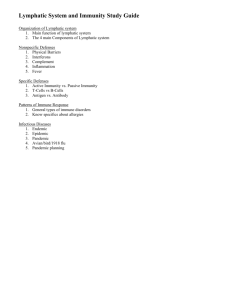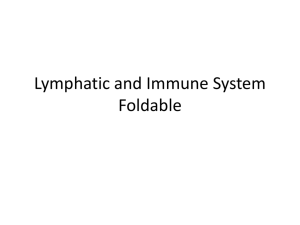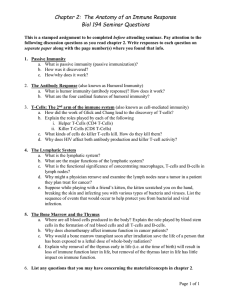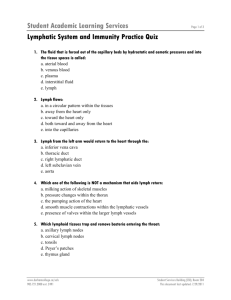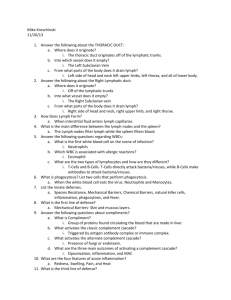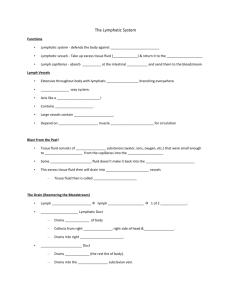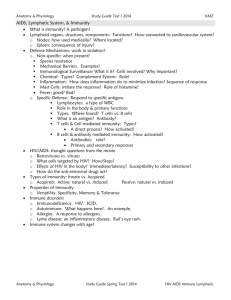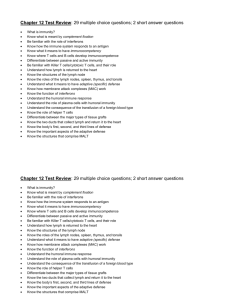Immune System
advertisement
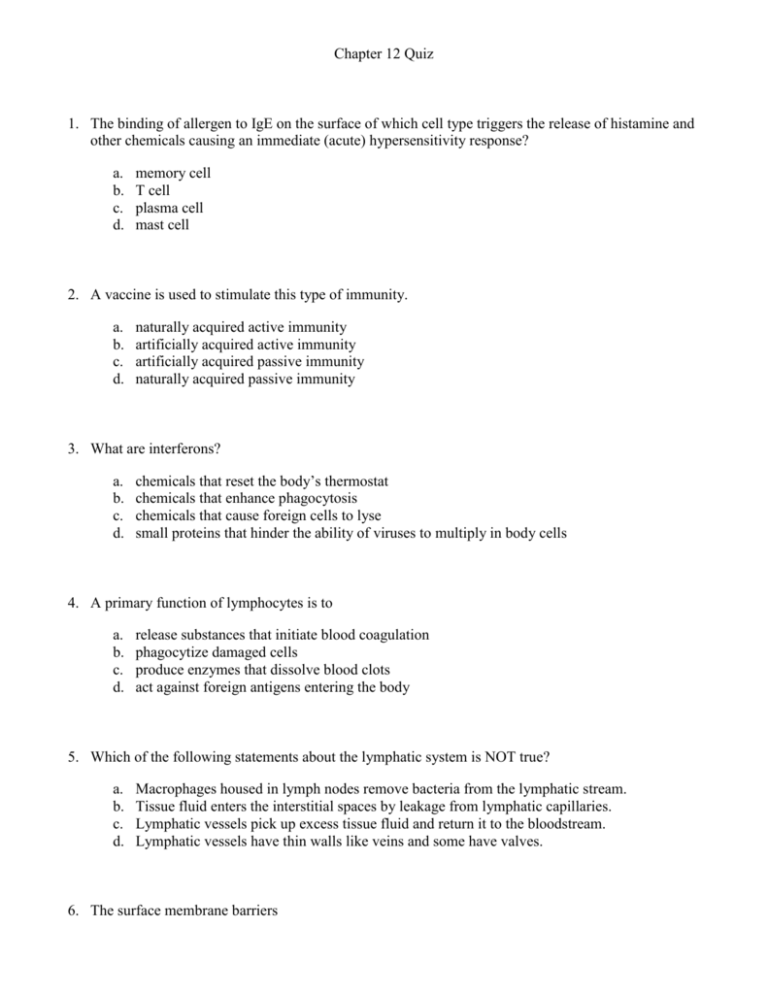
Chapter 12 Quiz 1. The binding of allergen to IgE on the surface of which cell type triggers the release of histamine and other chemicals causing an immediate (acute) hypersensitivity response? a. b. c. d. memory cell T cell plasma cell mast cell 2. A vaccine is used to stimulate this type of immunity. a. b. c. d. naturally acquired active immunity artificially acquired active immunity artificially acquired passive immunity naturally acquired passive immunity 3. What are interferons? a. b. c. d. chemicals that reset the body’s thermostat chemicals that enhance phagocytosis chemicals that cause foreign cells to lyse small proteins that hinder the ability of viruses to multiply in body cells 4. A primary function of lymphocytes is to a. b. c. d. release substances that initiate blood coagulation phagocytize damaged cells produce enzymes that dissolve blood clots act against foreign antigens entering the body 5. Which of the following statements about the lymphatic system is NOT true? a. b. c. d. Macrophages housed in lymph nodes remove bacteria from the lymphatic stream. Tissue fluid enters the interstitial spaces by leakage from lymphatic capillaries. Lymphatic vessels pick up excess tissue fluid and return it to the bloodstream. Lymphatic vessels have thin walls like veins and some have valves. 6. The surface membrane barriers a. b. c. d. are the body’s first line of defense against the invasion of disease causing microorganisms are capable of producing a wide variety of protective chemicals include mucus membranes that open to the exterior all of the above 7. Memory cells a. b. c. d. are derived from B-lymphocytes are derived from T-lymphocytes develop in response to a particular antigen all of the above 8. What type of graft involves transplanting tissues from a different animal species (i.e., a pig) into a human? a. b. c. d. xenograft autograft homograft allograft 9. The large phagocytic cells housed in the lymph nodes and elsewhere in the body that engulf and destroy bacteria and other foreign substances are a. b. c. d. lymphocytes natural killer cells B cells macrophages 10. Which of the following is NOT one of the four cardinal signs of an acute inflammation? a. b. c. d. heat redness opsonization pain 11. Lymph from the left side of the head, neck, chest, left arm, abdomen, and from both legs a. b. c. d. filters first through the spleen returns directly to the vascular system through the left carotid vein flows into the azygos (cardinal) vein drains into the thoracic duct 12. Autoimmune disease a. b. c. d. is another name for AIDS is what happens when your body loses the ability to identify self-antigens is what happens when your antigens begin to act as antibodies thus destroying your tissues is what happens when your body is invaded by a virus for the second time 13. An antigen is a. b. c. d. an erythrocyte a foreign protein a white blood cell which destroys bacteria by phagocytosis a T-lymphocyte 14. The AIDS virus infects a. b. c. d. Suppressor T-cells Helper T-cells B-cells Cytotoxic T-cells 15. Chemicals secreted by white blood cells that reset the body’s thermostat to a higher temperature are called a. b. c. d. opsonins interferons histamine pyrogens 16. This substance forms a barrier that helps to prevent the spread of pathogens or harmful agents from an area of damage to neighboring tissues a. b. c. d. lymph kinin histamine fibrin 17. This cell type is essentially an antibody producing factory. a. plasma cell b. T cell c. memory cell d. macrophage 18. Which of the following is true of cell-mediated immunity? a. b. c. d. It involves T-lymphocytes. It is involved in tissue and organ transplant rejection. Cells involved in this kind of immunity are clonal. All of the above. 19. The interferons are a group of chemicals produced by certain leukocytes in response to the presence of a. b. c. d. antibodies viruses blood parasites bacteria 20. Activated B-cells produce a. b. c. d. plasma cells and cytotoxic cells plasma cells and memory cells cytotoxic cells and memory cells B-cells and T-cells

